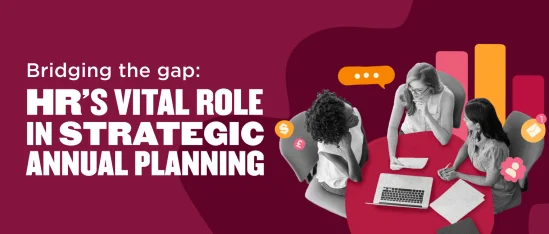For organizations across the world, the annual planning process is one of the most critical times of the year. It’s one of those big-picture business processes where organizations will set their strategies, allocate their resources, and align their goals for the year ahead.
But traditionally, it’s a strategic conversation that HR finds itself left out of.
However, as Sarah Reynolds (they/them), Chief Marketing Officer at HiBob, points out during their talk at CIPD, this is a missed opportunity. They believe that HR professionals have a plethora of unique insights into the type of workforce dynamics that are vital for realistic and effective planning.
And with the changing landscape of business strategies—HR’s involvement may be more crucial now than ever before.
Let’s explore how HR can align business strategy with people strategy and the role of HR in strategic planning.
The need for strategic HR in annual planning
Annual planning is a key process for organizations to ensure they have their strategic ducks in a row for the year ahead.
As Sarah puts it:
“It’s fundamentally one of the most important processes that organizations go through to set themselves up for success in the coming year … but oftentimes we see that HR folks are either left out or not necessarily considered to have the same strategic seat at the table as some of the other business functions. And I think that this is fundamentally amiss.”
This gap between business strategies and people strategies can hinder the annual planning process. HR leaders have the expertise and skill sets to help bridge this gap.
One of HR’s key roles includes offering vital data-driven insights, helping leaders understand data, and translating that information into actionable plans.
For example, understanding average time-to-fill metrics and how these differ regionally can make a huge difference in hiring processes. Consider that in the US, the average time to fill a position varies between 40 and 90 days, but in Germany, it can take up to six months due to longer notice periods.
HR possesses key insights that other stakeholders may not have access to—or even necessarily think of—that enable more precise planning across the board and help prevent unrealistic expectations.
Balancing the C-suite ideal and the HR reality
There can be a disconnect between the C-suite’s planning and the grounded realities of HR.
A CRO might have ambitious hiring targets that they believe will help push the organization forward, but HR leaders know all too well that finding qualified talent that fits hiring needs is challenging.
And when there’s a disconnect, plans can start to fall apart, as Sarah points out:
“According to our research with Lighthouse Research*, 58 percent of teams said that they missed their hiring plan last year. These teams further said that this put their annual business plan at risk because they had partners in the business who were counting on those strategic hires to help them get the work done.”
But when HR is involved in the process, they can help align hiring needs with the reality of the hiring process. They can offer data, such as the average time-to-fill for various roles and regions, forecast talent availability, and ensure that hiring plans and business cycles are in sync.
The recent surge in the use of AI is another good example.
AI and automation are transforming industries. But progress and change will always lead to concerns about job security and the future of work.
Some business leaders may be keen to jump onto the AI bandwagon and start weaving it throughout their business processes. And, with AI having such an explosive and immediate impact on the working world, there may be fears in the C-suite that if you don’t jump on board right away, you could get left behind.
But as with any new technology, there are always fears about its potential to impact people’s livelihoods and eventually replace certain jobs—bringing in the role of HR in change management.
“There’s a lot of uncertainty about what AI means at the team member level, and even at the leader level. And leaders are not always great at knowing how to answer some of those questions about that fear or uncertainty that’s coming from our team members.”
So, by HR having a seat at the strategic table, they can help the other leaders understand the fundamental and deep-seated fear that the modern workforce has around technology and take steps to address it.
HR leaders can tackle this in a number of different ways.
Whether that’s promoting a culture of change resilience and internal mobility, setting clear communication channels about the future of AI, or implementing training and development programs that upskill team members, to prepare their people for the new roles that may emerge from technological advancements while saving on hiring costs.
How HR can strategically step into organizational planning
For HR to take their place as valuable contributors to annual planning, it’s important to first understand where the organization stands in terms of workforce capabilities and align this with wider business goals.
HR can provide valuable input on key topics such as internal mobility, talent mapping, data analysis, and retention strategies—helping to create a more integrated and effective annual plan.
HR leaders can also leverage the power of technology to help streamline these processes, with smart HR tools that simplify tasks, allowing HR to focus on strategic initiatives.
“There’s [tech and] automation that can ultimately help you do your job a little bit easier and streamline some of that work. Then, the value that you bring to the annual planning process is not just spreadsheet data analysis, number crunching, [and] hardcore planning offline. But it’s rather that people-centric, consultative approach that’ll help your leaders see you as a strategic partner in the process.”
Because after all, it’s this blend of the strategic aspect of HR and annual planning and the people part of the job that is so important.
“Think about the people part of your job and think about how you show up as a leader in the annual planning process and say, ‘I can input not only into the strategic plan that goes on a slide or goes on a spreadsheet but also the strategic plan for how you communicate with your organization, how you offset some of that fear and some of that challenge.’”
Sarah hits on another key aspect there: communication.
Effective communication is vital in aligning HR strategy with business objectives. A key role for HR leaders is articulating insights and plans clearly to the C-suite, all while demonstrating how these contributions can help boost everything from morale to performance and drive organizational success.
Recommended For Further Reading
Planning for the future with strategic HR
Strategic HR planning isn’t just about getting a seat at the table; it’s about being a strategic partner that can drive organizations forward with a people-centric approach.
By providing data-driven insights, fostering internal talent, addressing technological fears, and leveraging the right tools, HR can help bridge the gap between business strategy and people strategy—providing crucial alignment for achieving business goals and maintaining a competitive edge.


